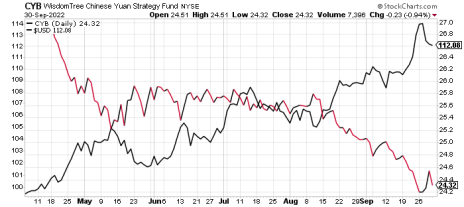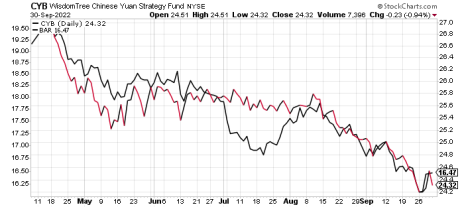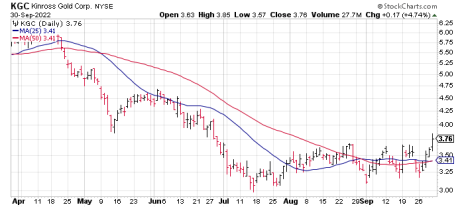Gold Suddenly Looks a Lot More Interesting
There’s no disputing that gold has been one of this year’s most “boring” markets. What started as a promising New Year—with investors almost unanimously expecting inflation to skyrocket (thereby boosting gold’s appeal)—has mostly seen rising interest rates and a strengthening dollar consistently undermine interest in the metal.
But as the dollar’s fortunes keep expanding at the expense of foreign currencies, several global players are growing weary of the greenback’s dominance, with at least one major country devising a plan to counter it. Should the plan succeed, gold could well come into its own in the coming months.
A plan to weaken the dollar made headlines last week when Reuters reported that China has made strengthening its yuan currency a “top priority.” The yuan is down more than 11% against the dollar year to date and is set for its largest annual decline in almost 30 years. This has prompted the People’s Bank of China to announce a stabilization plan for the currency, warning participants against making heavy one-way bets against the yuan.
Last month, the People’s Bank said it would reduce the amount of foreign currency (including the U.S. dollar) that China’s banks need to hold, a move designed to reduce pressure on the yuan, which the country blames partly on a strengthening dollar due to the Federal Reserve’s aggressive interest rate hikes.
This is a key consideration for gold, for the yuan is loosely pegged to the dollar and tends to trend inversely to it. The dollar versus yuan comparison has been especially pronounced this year, which the following graph illustrates. (The chart shows the dollar index (USD) versus the WisdomTree Chinese Yuan Strategy Fund (CYB), which tracks the yuan’s progress versus the U.S. dollar.)
China’s central bank also just ordered that financial institutions increase their foreign exchange risk reserves for purchasing currencies through forward contracts, which makes bets against the yuan more expensive. And in a separate report last Thursday, Reuters noted that Beijing has underscored its intent to strengthen the yuan at the greenback’s expense, telling major state-owned banks to “be prepared to sell dollars for the local unit in offshore markets,” with its sources saying the intervention plan involved using primarily the state lenders’ dollar reserves.
Additionally, Reuters quoted one of its unnamed sources as saying the scale of the latest round of dollar selling to defend the weakening yuan will be “rather big,” prompting more than a few market commentators to sensationally style the plan as a “massive dollar dump.”
But while many pundits are sensationalizing China’s currency stabilization plans, it’s worth mentioning that the last time China made major headlines to intervene in its currency market was back in 2015. And while the U.S. dollar and other global financial markets (including U.S. equities) were roiled by the effort, the impact was relatively short-lived.
Gold, meanwhile, appreciated during the yuan intervention in 2015 and proved to be a major safe haven during the August-to-October period that year while equity and currency markets were under serious pressure. Unlike the dollar, gold tends to trend in the same direction as the yuan, as the following chart of the yuan ETF (CYB) and the GraniteShares Gold ETF (BAR) demonstrates.
All told, while a significant dollar decline might not be in the cards, China’s latest currency intervention should provide at least a short-term catalyst for a gold rally. And while our favorite gold-tracking ETF hasn’t yet confirmed a breakout signal, any strengthening of the yuan from here should provide us with another buying opportunity.
Updates
As a temporary holding until the gold price outlook improves, I recommended a conservative position in the Invesco DB U.S. Dollar Index Bullish Fund (UUP) last week. I suggest using a level slightly under 29 as the stop-loss for this position, which is about where the psychologically significant 50-day line comes into play in the daily chart. BUY A HALF
We were stopped out of our conservative long position in my favorite nickel price tracker, the iPath Series B Bloomberg Nickel Subindex Total Return ETN (JJN), last week when the 30 level was violated on a closing basis. SOLD
Kinross Gold (KGC) is a senior mining firm that acquires, explores and develops gold properties in the U.S., Canada, Brazil, Chile, and Mauritania. Kinross was one of the few actively traded gold miners that posted higher revenue from a year ago in Q2, with total sales of $822 million increasing 16% from the comparable 2021 quarter. The company also reported cash and equivalents of $719 million, and total liquidity of approximately $2 billion, as of the quarter’s end, plenty of capital to take on new projects and fund existing operations. Management also provided upbeat guidance, with plans to “significantly” increase production in the second half of the year, primarily driven by stronger production at its Paracatu, Tasiast and La Coipa gold projects. Kinross expects all-in sustaining costs per gold equivalent ounce sold to be approximately $1,240—about $430 per ounce above the current gold price. On the development front, the company is proceeding with development of its 70%-owned Manh Choh project in Alaska, which is expected to increase the firm’s production profile by approximately 640,000 attributable ounces over the life of mine at lower costs. Kinross’s world-class Great Bear project in Ontario, meanwhile, continues to make excellent progress, with drilling results from the first half of the year continuing to confirm Kinross’ vision of developing a large, long-life mining complex. Most recently, Kinross announced approval from the Toronto Stock Exchange to increase its normal course issuer bid as part of the firm’s $300 million stock buyback program. The amendment increases the maximum number of common shares that may be repurchased (up to 65 million shares), representing 10% of the company’s public float. Purchases under the bid began August 3 and will end no later than next August 3. The stock is showing observable relative strength versus most actively traded gold shares, suggesting accumulation by informed interests is taking place. Participants can accordingly purchase a conservative position in KGC using a level slightly under 3.30 as the initial stop-loss on a closing basis. BUY A HALF
As previously discussed, white metals—particularly palladium—are holding their own relative to other metals. And while I’m not yet ready to pull the trigger on our favorite platinum/palladium ETF, I’m keeping a close watch on one of the biggest stocks in this segment, Platinum Group Metals (PLG). The South African-based company is focused on platinum and palladium production and operates the Waterberg large-scale platinum group metal (PGM) resource, which has an attractive risk profile given its shallow nature. The project also has the potential to be one of the lowest-cost operations in the PGM sector. An even bigger attraction for the company right now, however, is its partnership with Anglo American Platinum (ANGPY). The two companies have created Lion Battery Technologies to support the use of palladium and platinum in lithium battery applications. Lion has entered into an agreement with Florida International University to further advance a research program that uses platinum and palladium to unlock the potential of Lithium Oxygen and Lithium Sulfur battery chemistry, which can perform better, by orders of magnitude, than the best-in-class Lithium-ion batteries currently on the market. This new generation of lightweight, powerful batteries has the potential to grow to scale on the back of the attractiveness of electric vehicles (EVs) and the use of lithium batteries in other applications beyond mobility. Given that alternative energy is one of the market’s strongest performing sectors right now, this could position PLG to significantly outperform in the coming quarters. Accordingly, I’m recommending that we purchase a conservative position in PLG if the stock closes above 1.80 (the stock most recently closed at 1.63). BUY A HALF ABOVE 1.80.
| Stock | Price Bought | Date Bought | Price on Oct. 3 | Profit | Rating |
| Invesco U.S. Dollar Bullish ETF (UUP) | 30.3 | 9/26/22 | 30.2 | 0% | Buy a Half |
| Kinross Gold (KGC) | 3.75 | 10/4/22 | 3.75 | 0% | Buy a Half |
| iPath Bloomberg Nickel ETN (JJN) | 32.5 | 9/20/22 | 31 | -10% | Sold |
Buy means purchase a position at or around current prices.
Buy a Quarter/Half means allocate less of your portfolio to a position than you normally would (due to risk factors).
Hold means maintain existing position; don’t add to it by buying more, but don’t sell.
Sell means to liquidate the entire (or remaining) position.
Sell a Quarter/Half means take partial profits, either 25% or 50%.


